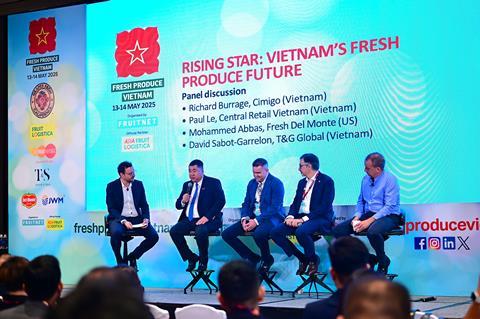While Vietnam has already emerged as a key market for the global fresh produce business, it holds massive untapped potential, heard delegates to Fresh Produce Vietnam

Vietnam has earned a reputation as a ‘rising star’ – both as an economy and a market for the global fresh produce business – over the past decade or so. And leading global players outlined the bright future for Vietnam’s consumer market and its fresh produce exports in the opening session to Fresh Produce Vietnam last week.
The brand-new event, organised by Fruitnet with official partner Asia Fruit Logistica, attracted almost 200 key decision-makers from across the local and international fresh produce business to the Sheraton Saigon Grand Opera Hotel in Ho Chi Minh City on 13-14 May.
Fresh Produce Vietnam featured a full day of expert talks and presentations exploring all aspects of the fast-developing market followed by curated tours to Ho Chi Minh City’s bustling Thu Duc wholesale market and leading food retail stores.
Setting the scene for the opening session ‘Rising star: Vietnam’s fresh produce future’, Richard Burrage, managing director of market research firm Cimigo, provided an overview of the macro trends in the consumer market and economy.
Vietnam’s economy has been growing at a staggering annual average of almost 6 per cent for the past ten years, Burrage revealed. The “powerful economic growth” continues to be driven by exports, a large proportion of which are now high-tech, and by foreign direct investment, he noted.
Nevertheless, Burrage pointed out that the economy is currently facing some headwinds with global uncertainty and the impact of US tariffs.
“Consumer and retail sales were muted last year,” he said. “It was a tough year. There was a bit of a splurge in spending after Covid, but we’ve seen people regather their savings, and consumer sentiment is below where it was in 2019. This has made the environment tougher for premium products.
Burrage said he expected consumer demand to remain muted in 2025. “The tariff news is impacting expectations on the market – it’s knocked a couple of percentage points off my GDP growth forecast for 2025 to around 4.7 per cent.”

Bright future
Despite the short-term volatility, he said there was every reason to be optimistic about Vietnam’s future. “The next decade is going to be awesome,” Burrage declared, citing several key drivers.
Rising household affluence and the rapid acceleration of the middle class is an engine of growth. “If we take the A, B, C and D consumer segments, they have household income above US$600 per month, so they have discretionary income to afford to buy imported fruits,” said Burrage. “ABCD today accounts for around 56m people, or over 50 per cent of households.”
“[Urban migration and lower birth rates mean] households are getting smaller, dependency is getting lower in those households, and they have more discretionary income.”
Burrage pointed to the high percentage of the working population in Vietnam as the biggest driver of growth. The working population (aged 20 to 64 years) made up some 62 per cent of the total in 2024, with 88 per cent of women in work and half of the working population aged between 20 and 39. “The contribution that women make to economic growth relative to neighbouring economies is phenomenal,” he noted.
Financial inclusion and digital payments are another catalyst. “If somebody asks me what’s the biggest trend in consumerism in Vietnam, it’s the leap frogging, the speed of change,” he said. “There was no real debit credit card culture here, we went straight to payment apps. Most people went straight to mobile phones. Almost 80 per cent of adults have a bank account. Digital payment is very common.”
The digital economy – now worth US$36bn, or 8 per cent of GDP – is growing rapidly, driven by online shopping, said Burrage. “If you’re looking at direct to consumer, a branded presence, Shopee is the number one with 48 per cent of the market last year, but TikTok has risen to number two in the past three years, and that means there’s a lot of livestreaming. It’s a very interesting space for brands to be speaking to consumers and educating them about your brand story.”
The growth of the modern retail trade, such as supermarkets, hypermarkets and convenience stores, is also fuelling the consumer market. “The traditional trade – mom and pop stores and wet markets – is now 62 per cent of total retail sales but for the first time ever, they saw an absolute decline last year,” said Burrage. “We’re seeing a large growth in the number of modern trade stores, a big growth in e-commerce. We’ve also seen rapid growth in fruit stores – modern trade outlets selling purely fresh produce – albeit off a low base.”
And in line with this, consumers are becoming healthier. “Vietnam is much more of a sporting community that it used to be,” said Burrage. “In the morning nowadays, you see people running, cycling, or on their way to yoga.”
“People are making healthier choices and they’re consuming more fresh produce. Of course, they still go to the wet market, to the traditional trade, but they also go to supermarkets where they find very good selections of fresh produce, nicely packaged and premiumised, and telling an origin story.”
“Curious consumers”
Central Retail Vietnam, which operates the upmarket Tops Market supermarket banner and the GO and Big C hypermarket formats in Vietnam, is one of the modern retail players reshaping the shopping experience for consumers.
In the opening panel discussion, vice-president of Central Retail Vietnam Paul Le explained how the foreign-invested retailer had been constantly evolving its model and offering since entering Vietnam more than 12 years ago, catering to the great diversity and dynamism of the consumer market.

Leveraging on Vietnam’s rich culture of growing and consuming fruits, he explained how the retailer was developing direct sourcing and festive promotions for domestically grown produce to drive consumption. Central Retail has worked with the Ministry of Agriculture, building connections with provincial governments and farmer associations and cooperatives, Le noted.
“We launched the mid-lunar new year fruit festival for tropical fruits from Vietnam to link into our culture to make very nice baskets of ripe fruits,” he said. “It’s a tradition from the south, so we promote the local lychees. This will be our third year of running the promotion [on 29 May] and we hope to launch it internationally in the future.”
New Zealand-headquartered global fruit marketer T&G Global has also reaped the benefits of its investments in Vietnam, which has become a star market for its proprietary apple varieties, notably Envy. T&G Global opened an office in Vietnam in 2019, began to import fruit directly in 2021, and now employs 15 people in the country, noted T&G Global’s Vietnam market manager, David Sabot.
“Our first step was to come into the country, our second was to establish our network of distributors and retailers and work through all channels. The next step is to address the consumer directly,” he said. “Since starting our own imports in 2021 we have doubled our volume, and we plan to more than double it again in the next ten years.”
Sabot said Vietnam’s strong fruit consumption culture made it a highly attractive market. “Nine of the top ten most consumed fruits here are locally grown – the only imported one is apples and apples are the second largest,” he said. “We have a very curious consumer in Vietnam – they will take a product from overseas and add their own profile, their own style. As a marketer, it’s very interesting to see what kind of innovation we can propose to consumers around a product.”
Structuring the market

Looking to the future, Sabot said the increasing sophistication of the consumer market would be a driver of growth in Vietnam. “We’ll go from education about the basic product to more interest in selected varieties and then relating that to brands. Over the next five years, I see the strong development of the imported premium category: apples in different channels, structuring of demand and more organisation in terms of the offer to the consumer.”
Le was equally optimistic about the consumer market evolution. “We are waiting for 35m new middle-class consumers to arrive. Currently, they’re young, they have an iPhone already. Whenever they travel, they learn, and we must tell them the story about the products.’
“Eight years ago, there were three types of apples in Vietnam – green, yellow and red. We had to teach consumers about the different varieties and to tell them about the different brands. This upcoming 35m middle class, they will spend a lot, and they’ll change the consumer profile.”
Export boom
Vietnam’s vast fresh produce potential is by no means limited to the consumer market, however. Already a major producer and exporter of tropical fruits, Vietnam is ready to spread its wings.
Fresh Del Monte’s chief operating officer Mohammed Abbas said he expected Vietnam to become the largest producer and exporter of bananas in Asia in the coming years, superseding the Philippines.
“The soil in Vietnam and the climatic conditions are perfect for banana production, and that’s why with some technical support, Vietnam can continue to grow in double digits.”
“Vietnam exported US$300m-worth of bananas in 2023. I think it could be a billion dollars three or four years from now.”
Abbas said Fresh Del Monte was looking to work with growers – small, medium or large size farmers – to develop their operations technically and source more bananas from Vietnam.
He said the multinational was also actively exploring opportunities to expand its pineapple sourcing in Vietnam – noting great untapped potential for the category.
While Vietnam’s proximity to some of the world’s most populous and high-demand markets gives it unique logistical advantages, Abbas also highlighted the opportunities to develop the tropical fruit offering for the domestic market.
“I see a big opportunity for convenience lines and the fresh-cut category here,” he said. “There’s a leaning towards out of home consumption, be it through convenience stores or even cafes. The number of coffee shops here is phenomenal. I think that trend for people wanting to consume out of home of will drive a fresh-cut rally.”

Expert talks
The opening panel discussion set the scene for a series of expert-led sessions exploring all aspects of Vietnam’s dynamic fresh produce business.
RedFern’s Ryan Molloy led a session on ‘Connecting with the Vietnamese consumer’ sharing in-depth insights on digital marketing, and he was joined for a case study by Rockit’s Global’s Hannah de Valda.

Hai Nguyen, CEO of leading boutique fruit retailer Klever Fruit, JWM Asia’s Danny Guo, and Laurent De Smedt of major Belgian cooperative BelOrta discussed the future of Vietnam’s fresh fruit imports. Ben Reilly of Australian company Steritech also explained the benefits of phytosanitary irradiation in facilitating market access and trade.
NielsenIQ director Johann Hall shared expert insights on Vietnam’s shifting food retail landscape, setting the scene for a lively panel discussion with Aeon Vietnam’s Chinh Bui, Blue Whale’s Benoit Barache, Jose Vottero of Fresh Fruit-X.
Vinafruit’s secretary general Dang Phuc Nguyen outlined the opportunities and challenges facing Vietnam’s booming fruit exports. Leading industry figures including Goodfarmer’s Andy Lu, Thao Nguyen of Hoang Phat Fruit Co and James Sexton of Exoriens Fresh then discussed the keys to market growth and diversification.
The conference programme rounded out with a look at how Vietnam can capitalise on its huge horticulture potential by attracting foreign investment and building more sustainable and profitable production systems. Siebe van Wijk of The Fruit Republic shared an in-depth case study on its Succeeds project to upgrade the citrus industry in the Mekong Delta while Will McFarland of the Dutch Fund for Climate and Development looked at investment models that can help overcome the challenges facing smallholder farmers.
To view the photo gallery from Fresh Produce Vietnam, visit the website.



